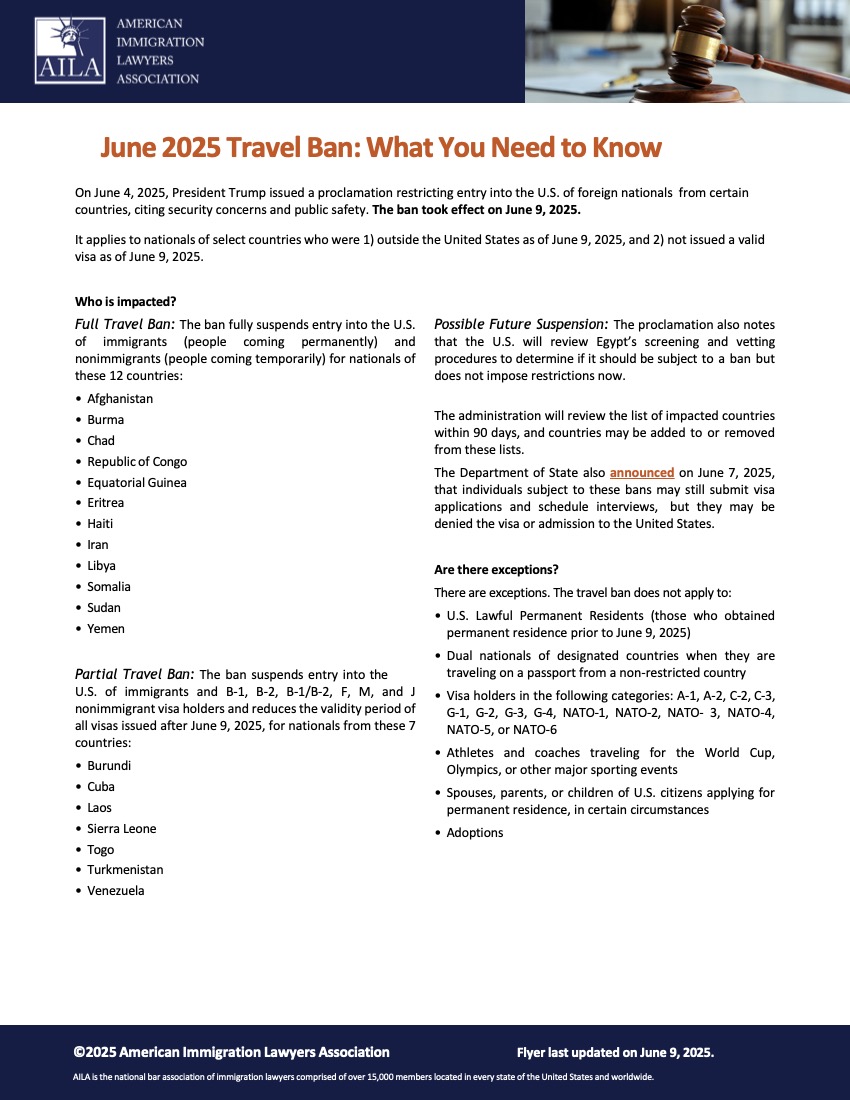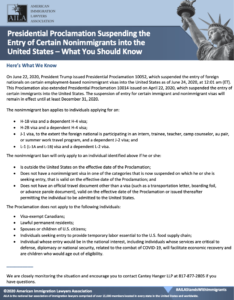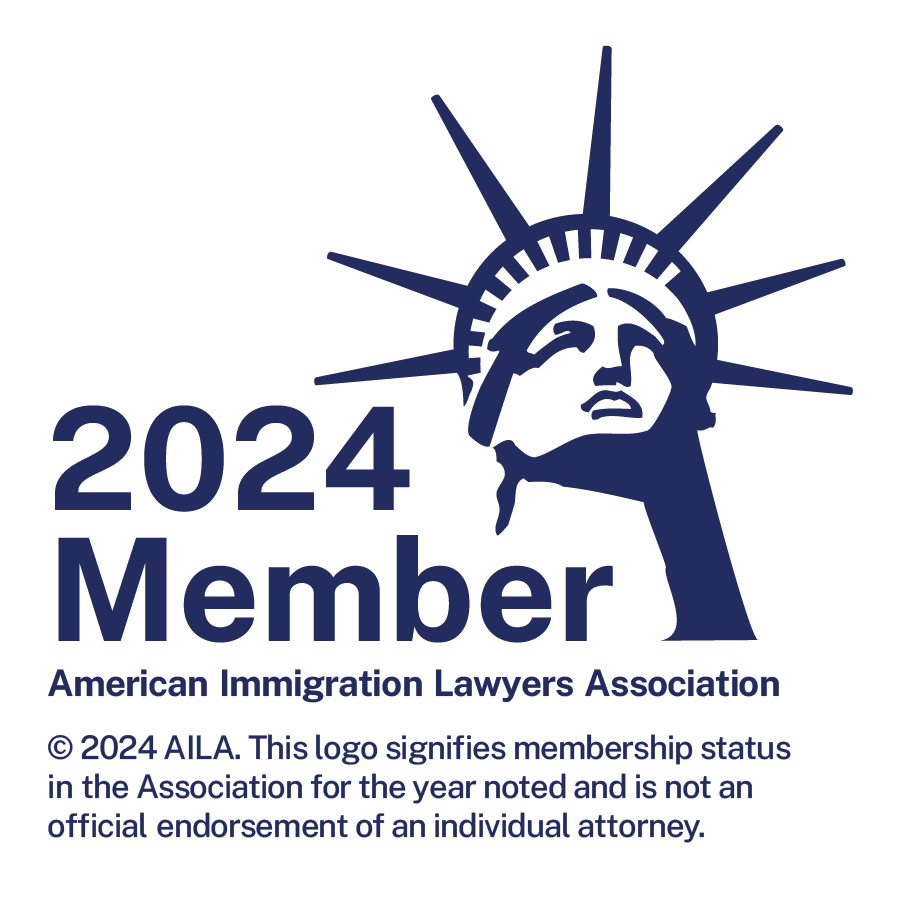The Biden Administration Immigration Policy – January 2021

The status of Trump’s H-1B rules now that Biden is in office
Forbes has posted a great article explaining the status of Trump’s H-1B rules under the Biden administration.
“During its four years, the Trump administration inflicted most of its immigration damage on businesses and high-skilled foreign nationals through memos, executive orders and proclamations. Near the end, Trump officials published two regulations to restrict H-1B visas and prepared a third rule for publication. Businesses, universities and H-1B professionals now wonder what the start of the Biden administration means for the fate of these three Trump-era H-1B rules.
One indication as to the fate of these rules came on Joe Biden’s first day. A January 20, 2021, memorandum sent by White House Chief of Staff Ronald A. Klain asked executive departments and federal agencies to postpone rules for 60 days that ‘have been published in the Federal Register . . . but not taken effect.’ The memorandum adds: ‘For rules postponed in this manner, during the 60-day period . . . consider opening a 30-day comment period to allow interested parties to provide comments about issues of fact, law, and policy raised by those rules, and consider pending petitions for reconsideration involving such rules. As appropriate and consistent with applicable law, and where necessary to continue to review these questions of fact, law, and policy, consider further delaying, or publishing for notice and comment proposed rules further delaying, such rules beyond the 60-day period.’
For rules not yet published, the memorandum states, ‘With respect to rules that have been sent to the OFR [Office of the Federal Register] but not published in the Federal Register, immediately withdraw them from the OFR for review and approval . . .'”
The U.S. Citizenship Act of 2021
President Biden is sending a bill to Congress on day one to “restore humanity and American values to our immigration system” per the press release.
Some highlights of the bill are set forth below. Exactly how these provisions will be implemented is not yet known.
Create an earned roadmap to citizenship for undocumented individuals. The bill allows undocumented individuals to apply for temporary legal status, with the ability to apply for green cards after five years if they pass criminal and national security background checks and pay their taxes. Dreamers, TPS holders, and immigrant farmworkers who meet specific requirements are eligible for green cards immediately under the legislation. After three years, all green card holders who pass additional background checks and demonstrate knowledge of English and U.S. civics can apply to become citizens. Applicants must be physically present in the United States on or before January 1, 2021. The Secretary of the Department of Homeland Security (DHS) may waive the presence requirement for those deported on or after January 20, 2017 who were physically present for at least three years prior to removal for family unity and other humanitarian purposes.
Lastly, the bill further recognizes America as a nation of immigrants by changing the word “alien” to “noncitizen” in our immigration laws.
Keep families together. The bill reforms the family-based immigration system by clearing backlogs, recapturing unused visas, eliminating lengthy wait times, and increasing per-country visa caps. It also eliminates the so-called “3 and 10-year bars,” and other provisions that keep families apart. The bill further supports families by more explicitly including permanent partnerships and eliminating discrimination facing LGBTQ+ families. It also provides protections for orphans, widows, children, and Filipino veterans who fought alongside the United States in World War II. Lastly, the bill allows immigrants with approved family-sponsorship petitions to join family in the United States on a temporary basis while they wait for green cards to become available.
Grow our economy. This bill clears employment-based visa backlogs, recaptures unused visas, reduces lengthy wait times, and eliminates per-country visa caps. The bill makes it easier for graduates of U.S. universities with advanced STEM degrees to stay in the United States; improves access to green cards for workers in lower-wage sectors, and eliminates other unnecessary hurdles for employment-based green cards.
The bill provides dependents of H-1B visa holders work authorization, and children are prevented from “aging out” of the system.
The bill also creates a pilot program to stimulate regional economic development, gives DHS the authority to adjust green cards based on macroeconomic conditions, and incentivizes higher wages for non-immigrant, high-skilled visas to prevent unfair competition with American workers.
“Incentivizes higher wages for non-immigrant, high-skilled visas” is concerning, as DOL just issued a final rule that increases prevailing wages and DHS issued a rule on a wage-based H-1B CAP lottery selection process. The Biden-Harris Administration is planning to issue a regulatory freeze on Trump’s “midnight regulations” that he issued in his final days, which should include these new H-1B rules. We will closely monitor actions and updates.
Hong Kong Executive Order
Because of this July 14, 2020 Executive Order, there is great concern whether persons born in Hong Kong will be chargeable to the China visa category. The Visa Office continues to review this issue but there is legal authority that the Order cannot alter the separate chargeability of Hong Kong. Section 103 of the Immigration Act of 1990 granted the separate chargeability treatment to persons born in Hong Kong. Section 103 states that Hong Kong will be treated as a separate foreign state, “and not as a colony or other component or dependent area of another foreign state.” Stay tuned for updates on this important issue.
Presidential Proclamation Update
The US Department of State confirmed, “If you were in the US on June 24th but left and your visa expired, you are not subject to the Proclamation [and] may renew your visa before December 31, 2020.”
In a reversal of prior guidance, the US Department of State announced via Twitter that Presidential Proclamation 10052 of June 22, 2020, amending Presidential Proclamation 10014 of April 22, 2020, does not apply to H-1B, H-2B, J-1, and L nonimmigrants who were physically present in the United States on June 24, 2020, and whose visas in one of the affected categories subsequently expired. Thus, should an individual who was in the United States on June 24, 2020, leave the United States and require renewal of a visa to return, the individual is eligible to apply for a new visa at a US consulate/embassy abroad once routine visa services become available.
As always, please contact Cantey Hanger before you finalize any international travel plans and the situation is subject to change.
Presidential Proclamation Suspending the Entry of Certain Nonimmigrants into the United States – What You Should Know
PRESIDENT TRUMP’S JUNE 22, 2020 PROCLAMATION
We are all aware that this proclamation suspends the entry into the U.S. of certain H-1B, H-2B, J and L nonimmigrants and their spouses and children.
There are few exceptions and they primarily focus on the national interest of the U.S. including providing medical care or medical research for COVID-19, providing services critical to defense or law enforcement, and providing services that facilitate the economic recovery of the U.S.
Be aware that this proclamation also instructs other actions to be taken to ensure that the presence in the U.S. of H-1B nonimmigrants and those seeking EB-2 or EB-3 benefits do not disadvantage U.S. workers. There are no details provided at this time as to what these actions may be, but speculation abounds that they could include an increase in Department of Labor audits of labor certifications and possibly re-testing of the market for labor certifications.
Trump’s Tweet and COVID-19 Effects on Immigration
President Trump tweeted late Monday night (4/20/2020) he plans to temporarily suspend immigration into the United States. What does this mean?
We won’t have specific details until the Executive Order (EO) is released, which should be sometime this week. Rumors are circulating that this may be for a 120 day period. This announcement is troubling but not surprising given Trump’s attempts and successes in limiting immigration already, and he can attribute the necessity of this EO to the pandemic. We will post updates on this EO as they become available.
Can nonimmigrants be eligible to receive a stimulus check under the CARES Act?
To receive the payment, the recipient must have a valid Social Security number and qualify as a resident alien as defined by the Internal Revenue Service. To qualify as a “resident alien,” one must either meet the green card test or the substantial presence test. To pass the “green card” test, one must be a lawful permanent resident, i.e., green card holder, at any time during the calendar year. The “substantial presence” test is also based on the calendar year. One must have been physically present in the U.S. during the calendar year for a specific minimum period of time per IRS rules. Some nonimmigrants are exempt from the physical presence calculation such as F-1 students. Most work authorized nonimmigrants (H-1B, L-1, O-1, and TN) are not exempt. More information on the substantial presence test can be found here: https://www.irs.gov/individuals/international-taxpayers/substantial-presence-test. Please consult a Certified Public Accountant with any IRS-related questions.
Please note: Individuals who do not have a valid Social Security number and used an ITIN to file their taxes are not eligible for a stimulus check. In fact, the CARES Act denies the rebate to an eligible individual with a Social Security number if that individual filed a joint return with a spouse who has an ITIN, or filed a return with a qualifying child who has an ITIN. (Limited exceptions apply in adoption or military situations.)
As a nonimmigrant, if I receive a stimulus check, is there a risk in accepting and cashing it?
A new Public Charge rule went into effect on February 24, 2020. This rule is the basis for concern over receiving a stimulus check and whether that will lead to a public charge determination. The recovery rebates are considered tax credits. Tax credits are specifically excluded from public benefits in the Public Charge rule and are not taken into account in making a public charge determination.
How can I renew my driver license (DL) with Department of Public Safety offices closed?
DLs are extended for 60 days per order of the Governor of Texas.
In accordance with section 418.016 of the Texas Government Code, the Office of the Governor approved the Department’s request to suspend provisions of the Texas Transportation Code to the extent necessary to delay the expiration date of Driver Licenses (DL), Commercial Driver Licenses (CDL), Personal Identification Cards (ID), and Election Certificates (EIC).
If your Texas DL, ID, CLP, CDL card or EIC expires on or after March 13, 2020, you are granted a waiver for the expiration date for 60 days after the Department provides further public notice that normal operations have resumed. You may download a copy of the Verification of Driver License Expiration Extension (PDF) notice. All local and state law enforcement officials have been notified of this expiration waiver. When the Department resumes normal operations, you will be able to renew without any penalty.
A close reading of the DPS notice reveals it is not consistent in how it defines the extension of DLs. The most favorable interpretation is the following:
(1) The expiration date on the DL is on or after March 13, 2020; and
(2) DLs remain valid for the duration of the governor’s declaration of State of Disaster for the State of Texas AND for 60 days after DPS provides further public notice that normal DPS operations have resumed.
So, for now, there is no definitive end date for the validity of DLs because the State of Texas is still under a State of Disaster.
I am an H-1B temporary worker and as a result of COVID-19, my worksite has changed. What do I need to do?
If the change in work location remains within the same metropolitan statistical area as the work location listed on the existing and valid Labor Condition Application (LCA), and this new work location is not listed on the original LCA, a new LCA posting must be done. The “same metropolitan statistical area” typically means within normal commuting distance. Currently, most employees are having to work remotely from home, and very likely, their home is within normal commuting distance of their office.
Consequently, employers must post LCA Notices at the new worksite location that is within normal commuting distance of the certified LCA worksite location no later than 30 days after the H-1B or E-3 worker begins work at this new location. This additional posting can be either via a hard copy posting (e.g. on the refrigerator at the worker’s home) or electronic.
If the change in work location is outside of the metropolitan statistical area stated on the LCA, a new LCA and amended H-1B petition are required unless short-term placement rules can be utilized.
Consult with an attorney for detailed advice and instructions concerning your specific situation.
I’m in H-1B status and my employer wants to reduce my hours from full-time to part-time. Is that okay? Also, can my pay be reduced because of lack of work during the pandemic?
A reduction in hours is a material change in the job offer. Consequently, a new Labor Condition Application (LCA) and amended H-1B petition must be filed prior to the employer reducing the hours of work.
Regarding wages, the H-1B employer is required to pay the higher of the prevailing wage or actual wage as specified on the LCA and in the H-1B petition throughout the validity period of the H-1B.
An H-1B employee may not be put in non-productive status without pay, due to the decision of the employer or for the employer’s benefit. This includes furloughing the employee for lack of work or “benching” that employee.
In the case of company-wide salary cuts in response to an economic crisis, an employer should ensure any adjustments to an H-1B employee’s salary keep the salary at or above the prevailing wage rate. The wages paid to the H-1B must still be at least the higher of the adjusted actual wage or prevailing wage for that occupational classification and in the area of intended employment. The employer must place a memo in each applicable Public Access File documenting this adjustment in wages.
On the other hand, if the employee voluntarily requests leave for a personal reason, such as maternity leave or to care for a family member, then the employer is not required to pay the H-1B worker during that leave for personal reasons. Keep in mind, though, that the employer may still be obligated to pay the required wage if subject to payment under the employer’s benefit plan, or acts such as Family and Medical Leave Act, the Americans with Disabilities Act, or the Families First Coronavirus Response Act.
Can nonimmigrant workers in H-1B, L-1, E-3 or TN status receive unemployment insurance?
To maintain valid nonimmigrant status in those classifications, the nonimmigrant must remain employed by the petitioning employer. If they are terminated or quit working for that employer, barring a 60-day grace period within which to file a new petition or depart the U.S., the nonimmigrant is out of status. Filing for unemployment insurance is an indication the person is not working and hence, out of status. Further, to be eligible for unemployment benefits, the person must be available and ready for full-time work. Persons in the nonimmigrant categories mentioned above are not immediately available or ready for work due to the immigration process that must be conducted first.




